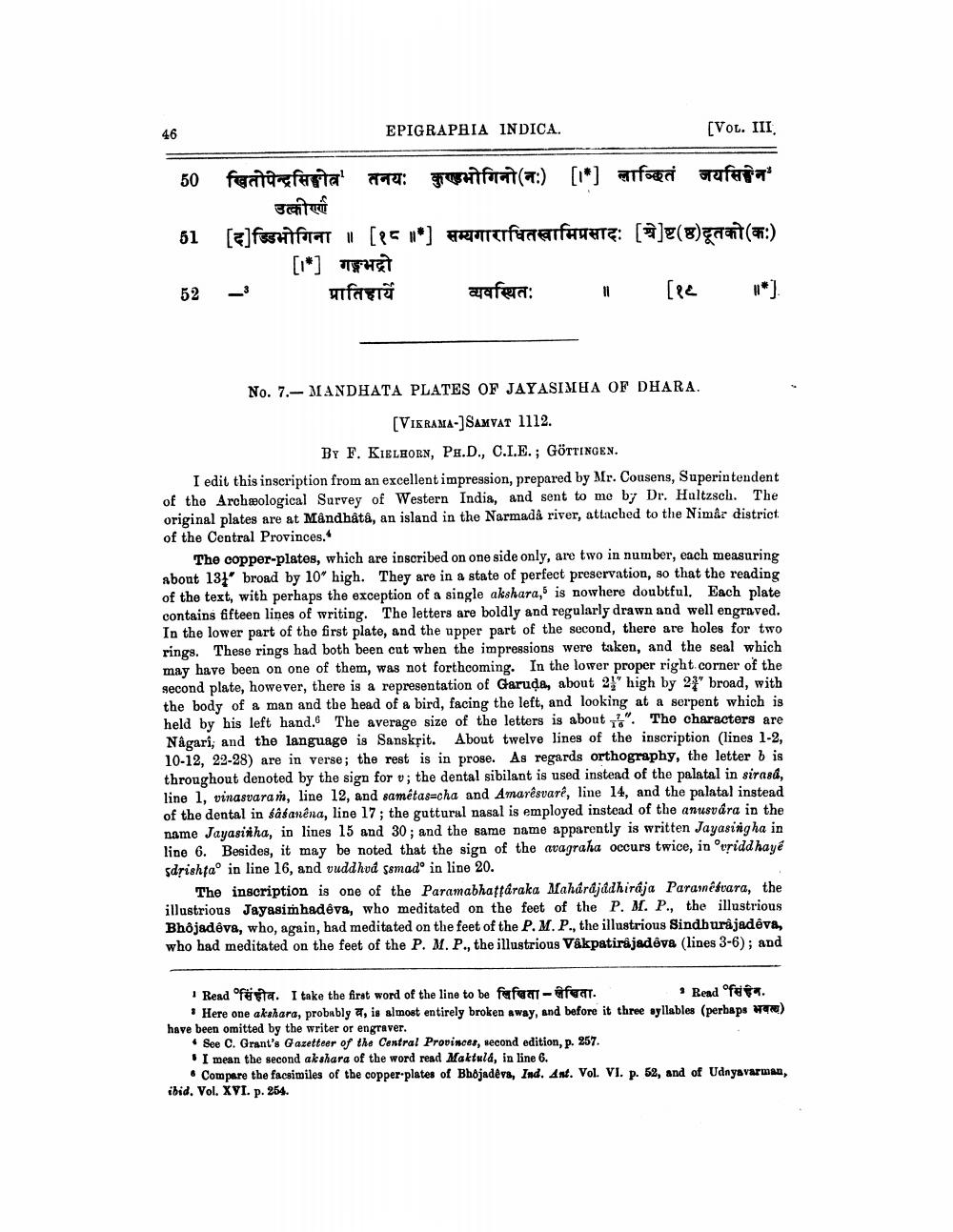________________
EPIGRAPHIA INDICA.
[VOL. III
50 femtarefastal valu: artiforait (:) [l*] atrament offertas
उत्कीर्ण 51 [x]fastilforat [P5 in) trofurafatura: [a]e(r)nat (?:)
[1*] TEET
प्रातिहार्ये arafera: [lc *)
52
-3
No. 7.- MANDHATA PLATES OF JAYASIMEA OF DHARA.
(VIERAMA-]Samvat 1112.
By F. Kielzorn, Pu.D., C.I.E. ; Göttingen. I edit this inscription from an excellent impression, prepared by Mr. Cousens, Superintendent of the Archeological Survey of Western India, and sent to me by Dr. Haltzsch. The original plates are at Mândhâtâ, an island in the Narmada river, attached to the Nimär district of the Central Provinces.
The copper-plates, which are inscribed on one side only, are two in number, each measuring about 131' broad by 10' high. They are in a state of perfect preservation, so that the reading of the text, with perhaps the exception of a single akshara, is nowhere doubtful. Each plate contains fifteen lines of writing. The letters are boldly and regularly drawn and well engraved. In the lower part of the first plate, and the upper part of the second, there are holes for two rings. These rings had both been cut when the impressions were taken, and the seal which may have been on one of them, was not forthcoming. In the lower proper right corner of the second plate, however, there is a representation of Garuda, about 2 high by 23 broad, with the body of a man and the head of a bird, facing the left, and looking at a serpent which is held by his left hand. The average size of the letters is about 1". The characters are Någari, and the language is Sanskřit. About twelve lines of the inscription lines 1-2, 10-12, 22-28) are in verse; the rest is in prose. As regards orthography, the letter b is throughout denoted by the sign for v; the dental sibilant is used instead of the palatal in sirasa, line 1, vinasvaraṁ, line 12, and samétas-cha and Amarêsvarê, line 14, and the palatal instead of the dental in sâsanêna, line 17; the guttural nasal is employed instead of the anusvåra in the name Jayasinha, in lines 15 and 30; and the same name apparently is written Jayasingha in line 6. Besides, it may be noted that the sign of the avagraha occurs twice, in 'vridd hayé sdrishfa in line 16, and vuddhva somado in line 20.
The inscription is one of the Paramabhattáraka Maharajadhiraja Parasnéfrara, the illustrious Jayasimhadeva, who meditated on the feet of the P. M. P., the illustrious Bhôjadêva, who, again, had meditated on the feet of the P.M.P., the illustrious Sindhurajadêva, who had meditated on the feet of the P. M. P., the illustrious Våkpatiråjadova (lines 3-6); and
I Read °सिंहीव. Itake the firat word of the line to be लिखिता-लिखिता.
Read Ofen Here one akshara, probably a, is almost entirely broken away, and before it three syllables (perbaps W ) have been omitted by the writer or engraver.
• See C. Grant's Gazetteer of the Central Provinces, second edition, p. 257.
I mean the second akshara of the word read Maktula, in line 6. * Compare the facsimiles of the copper plates of Bhojadeva, Ind. Ant. Vol. VI. p. 52, and of Udnyavarmaa, ibid. Vol. XVI. p. 254.




